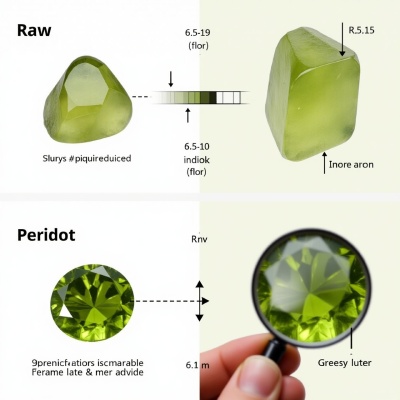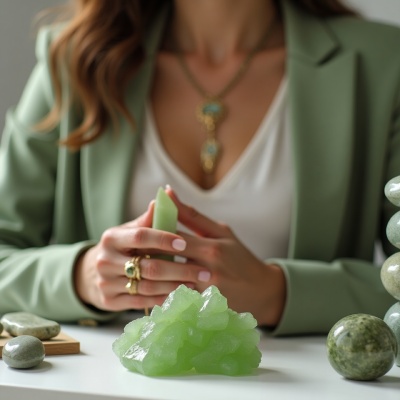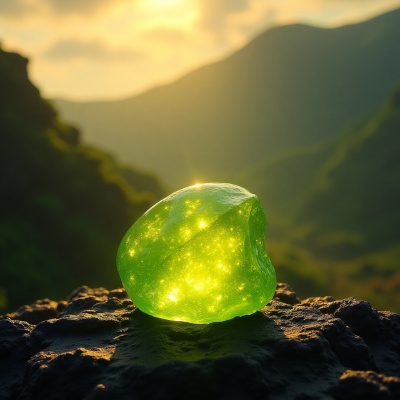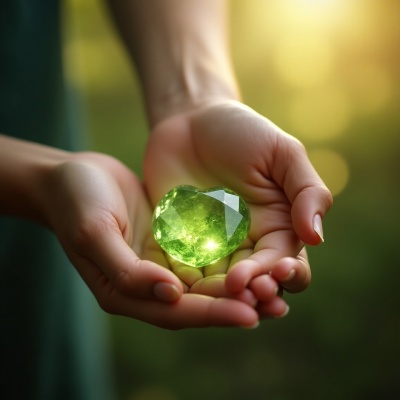
Introduction to Peridot
Discovering the Essence of Peridot
The Peridot is a stunning gem and a variety of olivine with a vitreous luster and belongs to the orthorhombic crystal system. Rich in magnesium and shaped by its iron content, it shines in shades of yellow-green, olive green, and dark green. Its meaning of purpose and focus connects deeply with me. Named from the French word “peritot”, meaning gold, its golden glow and intense green color make it one of the few gemstones known for healing properties and prized since ancient times.
Peridot's Fiery Origins
Peridots are formed deep inside the earth and rise through volcanoes. The volcanic island of Zabargad in the Red Sea was a main source. I admired ancient Egyptian jewelry with this stone, once believed to carry the blessing of sun gods, symbolizing power and influence. A Hawaiian legend says they are the tears of Pele, goddess of fire.
Modern Treasures in Peridot
Today, Arizona, United States, yields most Peridot, found in veins within pallasites volcanic rocks. Always in one color, a vivid green, its tint depends on iron in its crystal structure. Known to mineralogists, bible enthusiasts, and historians as chrysolite, from the Greek word for goldstone, it’s truly timeless.
Physical Characteristics and Natural Origins

In my years of working with gems, Peridot has always fascinated me for its natural green color, which can appear as a light olive tone or shift into deep, rich hues with an almost emerald vibe depending on the intensity of iron present.
This ancient gemstone has a hardness of 6.5-7 on the Mohs scale, making it durable for everyday jewelry, just slightly below sapphire and ruby in strength.
What’s truly incredible is that it forms deep in the earth’s mantle and reaches the surface through tectonic activity, often found as gem-quality crystals in igneous rocks like basalts. I’ve personally sourced stones that were mined across the globe in Arkansas, Arizona, China, Myanmar, Pakistan, and Africa each region lending subtle differences in tone.
A well-cut stone shows a luminous glow, enhanced by its slightly oily or greasy luster. Even with natural inclusions, its beauty is never lost when cut and finished into elegant gemstones.
Everyday Uses

I’ve always found Peridot to be more than just a gem its beauty, calming energy, and naturally vibrant presence make it incredibly practical in daily life. I enjoy the many creative ways this green stone fits into modern living, offering more than just its sparkle.
Jewelry
Wearing jewelry made of Peridot like rings, bracelets, necklaces, or earrings adds a lovely addition to any outfit. The bright green colors instantly uplift my look, and because the gemstone is common, it’s both affordable and ethical, making it perfect for daily wear without worry.
Home Decor
In my home, I like to display crystals and tumbled stones throughout different spaces. Their joyful vibe and green energy bring warmth to my living rooms, bedrooms, and especially the workspace. It helps stimulate my creativity, encourages mental clarity, and subtle gemstone accents make every space feel calm and inspired.
Meditation
I often hold the stone during meditation to amplify deep intentions around growth, renewal, and emotional healing. Placing it on the body at key energy points can clear emotional blockages, especially when I sit for chakra healing. It helps align and balance my heart chakra, and keeping one under my pillow or by the bed even helps me ward off nightmares and get truly restful sleep.
The Secrets of Peridot

I first encountered Peridot on a trip to Oahu, where the sunlight danced across the verdant lands, making everything brim with beauty. This lively, bright green gemstone caught my eye not just for its color but for its rich history and the good-luck vibes it carries. Often called the poor man’s emerald, it comes in shades of golden, olive green, and lime green, thanks to its origin in olivine. Formed deep in the earth’s core, it emerges through volcanic cracks with raw energy, a product of fire and time. From the Red Sea to Hawaii, and even places like Brazil, Pakistan, and Australia, Peridot continues to be a precious stone revered by many across the ages.
Legends say Cleopatra loved this lustrous gem, referring to it as the Emerald of the Evening. Back in ancient times, Egyptian queens, Pharaohs, and even high priests and kings believed it could ward off evil spirits and help them feel calm and safe. Mined on a remote island once called Topazios in Greek, it was guarded fiercely so much so that trespassers were punished with death. I remember hearing tales of miners using singing hammers to unearth these crystals, destined to rest on deathbeds of royalty. That island was strictly off-limits, yet Peridot has survived, its playful smattering of light and glimmering greens continuing to captivate anyone drawn to its powerful spirit.
Mental & Emotional Healing Properties

I first came across Peridot during a meditation retreat in a quiet part of the mountains. The twinkling green gemstone caught my attention immediately not just for its beauty, but for the undeniable energy it seemed to radiate. Since then, it’s become my personal go-to for supporting mental and emotional clarity. This potent crystal is known for its healing properties, helping to alleviate stress, anxiety, and even the heavy baggage of bitterness, resentment, and jealousy that can be deeply marred into our soul. Whenever I feel anxious or stuck in negative emotions, I hold Peridot to my heart and let it purge what no longer serves me, creating a space of peace and calm. There’s a certain glow it brings that feels like stepping into sheer sunlight, clearing away egocentric behavior patterns that block the path to a well-lived life.
What makes Peridot stand out is not only its emotional support but also its connection to clear thinking. Often called the Study Stone, it has the innate ability to invite deep focus something I deeply appreciate during academic challenges or any task that feels taxing. It helps me cut through distracting threads of thought and stay present until the job is done. In that sense, Peridot has become a reliable companion, one that gently pushes you to persevere while helping to stabilize shifting moods and bring emotional balance to the whole body, mind, and soul. It’s a great stone that seems to truly serve those seeking wellness, showing how the light of a pure, empty-handed heart can reflect into the world and help shape a more purposeful path forward.
FAQ'S:
What does Peridot mean spiritually?
Spiritually, Peridot is known as a stone of transformation and cleansing. It symbolizes growth, renewal, and emotional release, helping to clear away past baggage and negative patterns while opening the heart to joy, love, and inner peace.
What chakra is the Peridot stone for?
Peridot is primarily connected to the heart chakra, promoting emotional healing, forgiveness, and compassion. It helps in balancing feelings and encouraging a free flow of love and positive energy through the heart center.
What power does Peridot have?
Peridot is believed to have powerful healing properties that support mental clarity, emotional balance, and protection from negative influences. It’s known to reduce stress, enhance focus, and guide you toward a more peaceful and centered state of mind.
Can you sleep with a Peridot?
Yes, you can sleep with a Peridot. Keeping it close while sleeping is thought to calm the mind, reduce anxiety, and promote restful sleep by easing emotional burdens and negative thoughts.
Which hand should a woman wear a Peridot stone?
Traditionally, a woman should wear a Peridot stone on her right hand. This is believed to enhance the stone’s ability to attract prosperity, emotional strength, and personal growth by aligning with the body’s active energy channels.
